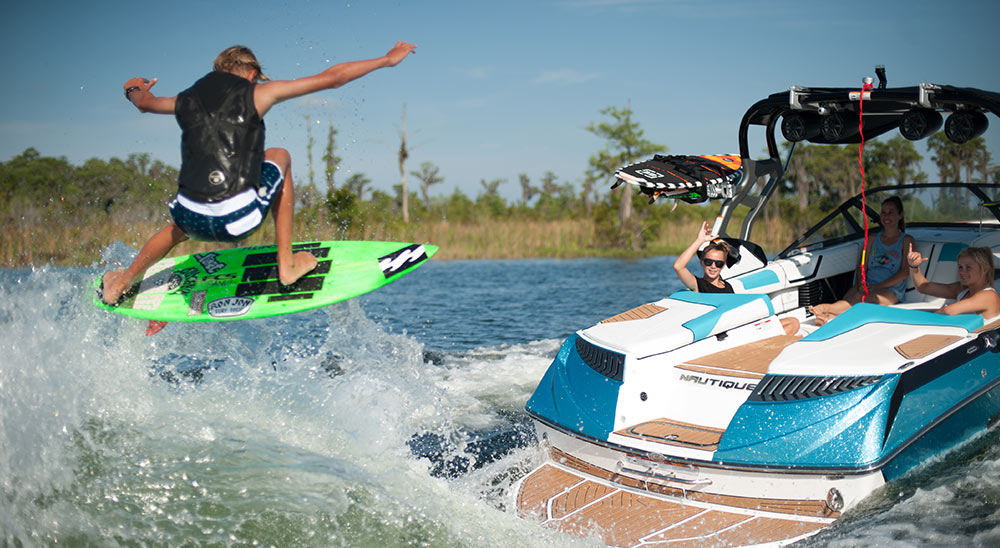How to Wakesurf
Catch the wave and join the hottest trend in watersports: wakesurfing. Our experts at boats.com will teach you the basics to help you get started.
In watersports, there is one sport that dominates the rest: wakesurfing. Not only have boat manufacturers altered their designs in order to better accommodate the sport, but wakesurfing has also found a way to revolutionize the industry. So for right now, forget about all those other watersports—skiing, wakeboarding, kneeboarding—because it’s time to concentrate on the hottest sport on the water.

Wakesurfing has become one of the hottest trends on the water, and it's popularity only continues to grow—along with the technology that powers it.
The basic steps in learning how to wakesurf:
- Start by floating on your back with your knees bent.
- Rest your heels on the board with your toes pointing up.
- Hold onto the towrope as the boat begins to accelerate.
- Keep pressure on your heels so the board can flip up to meet your feet.
- Once the board is on a plane, stand with your knees bent and arms straight out in front of you.
- “Hold an edge”—which means, keep the board on the side of the wake.
- Position yourself in the wake pocket—this gives you the most power and momentum to continue moving with the boat.
- Accelerate speed by apply weight to your front foot, or decelerate by applying pressure to your back foot.
- Coil up the towrope if necessary to keep your board in the pocket of the wake.
- Once you’re comfortable, let go of the rope and ride the momentum in the wake pocket.
Now that you understand the basics, there are a few other important things to keep in mind as you start your wakesurfing journey.
The boat
Always wakesurf behind an inboard boat. With the propeller tucked underneath the transom, it allows for a safer ride since wakesurfers tend to stay close to the back of the boat in the wake.
There are plenty of boats on the market that are specifically designed for wakesurfing—you can find tons of these wakesurfing boats listed on boats.com. What makes these boats special is the way they are constructed. Many new wakesurfing boats now include the Volve Penta Forward Drive and surf-specific hulls that maximize the designs in order to create the largest, crispest wakes possible.
The key to creating the perfect wake is all about ballast. You want to have the majority of the weight balanced to whichever side of the boat your surfer intends to ride. Adding weight to the back of the boat can also help to increase the size of the wake.

Surfers need to find their "sweet spot" in the wake pocket, which helps propel them forward with power and momentum.
The driver
Be sure you have an experienced captain at the wheel. It’s important to keep the boat anywhere between nine to 13 MPH—depending on your boat size, make, model, and of course, preference of your wakesurfer.
The board
Although the sport is called “wakesurfing,” we don’t recommend trying to ride an actual surfboard—save those for the beach. Instead, there are specifically designed boards that are used for wakesurfing. Beginners should try riding a large “surf style” board, which is constructed to be larger and thicker than the smaller, agile boards that are more difficult to ride. These larger boards are also more buoyant and assist in stability.
The towrope
The towropes used for wakesurfing are typically a little different from towropes used for other watersports like skiing or wakeboarding. For wakesurfing, it’s best to use a towrope that’s much thicker and even much shorter. Wakesurfing ropes have a T-bar or small handle, and they tend to have knots or grip areas that help riders pull themselves into the “sweet spot” in the wake pocket.
To check out some wakesurfing action and learn more about the equipment that helps to power the sport, watch the Tige ZX5 review:
Wakesurfing is a trend that only seems to be growing, so don’t be afraid to catch the wave and become a part of the movement. Our tips can help you get your feet wet, and be sure check out these additional articles if you’re interested in diving into other watersports:
- Watersports: All Things Towable
- How to Wakeboard
- 20 Tips for Instant Wakeboard Success
- How to Kneeboard
- Safe Family Tubing
- Essential Tow-Boat Glossary
- How to Stand Up Paddleboard (SUP) and Stay Dry












